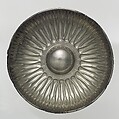Bowl with a radiating petal design
Not on view
The Phrygians ruled in Central Anatolia, from about 800 to 700 B.C., from their capital at Gordion. King Midas, known in myth to have turned all he touched to gold, may have been the person buried in the great tumulus at Gordion. That tomb contained many drinking bowls made of brass (which in antiquity would have had a bright golden color) with a raised knob in the center allowing it to be held comfortably from underneath.
This silver bowl, with a fine petal design with graceful stems radiating from a central raised knob, is a variation on many of the drinking bowls from the Gordion excavations. Thus, there is a possibility that this vessel was made by the Phrygians. But the Lydians, who ruled in western Anatolia from 685 to 547 B.C., admired objects of Phrygian manufacture, and this silver vessel may have in fact been made by the Lydians.
Due to rights restrictions, this image cannot be enlarged, viewed at full screen, or downloaded.

